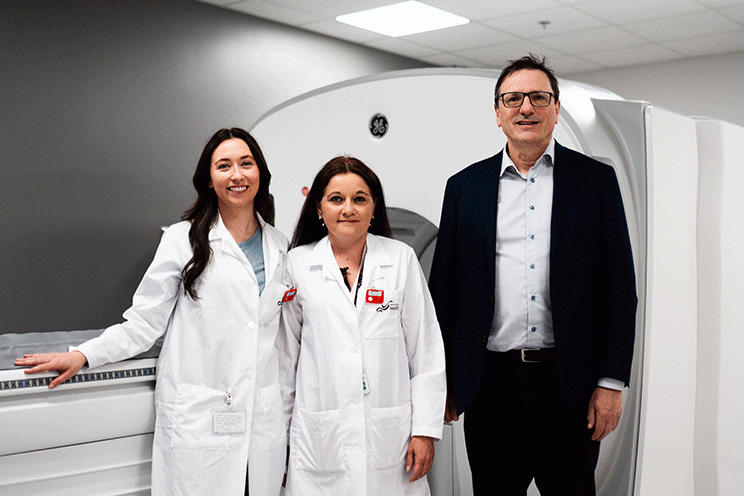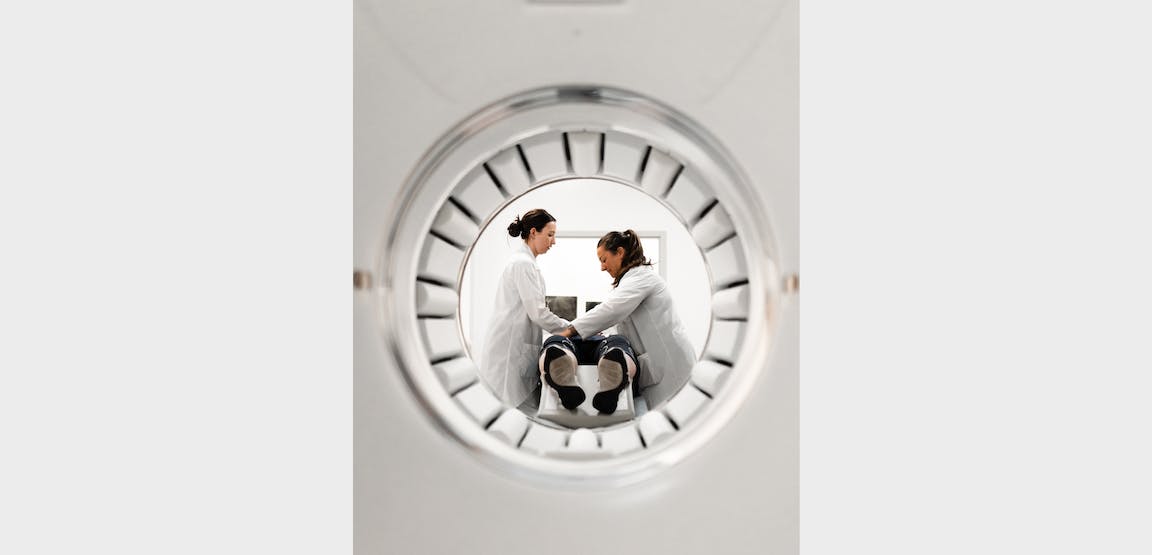
Dr. Steven Burrell (right), the QEII’s head of nuclear medicine, and nuclear medicine technologists Sara Amero (left) and Alicia Burke (centre) with Canada’s first StarGuide Hybrid SPECT/CT nuclear medicine scanner, which arrived at the QEII last spring. UNCHARTED MEDIA
A first in Canada, donor-funded nuclear medicine scanner is helping QEII physicians assess and diagnose diseases with precision that wasn’t previously possible — all while tackling waitlists with greater efficiency
Last spring, Canada’s first StarGuide Hybrid SPECT/CT nuclear medicine scanner by GE HealthCare arrived at the QEII Health Sciences Centre, ushering in a new era of nuclear medicine. It’s what Dr. Steven Burrell, the QEII’s head of nuclear medicine, describes as a “paradigm shift.”
“In the first month, we’ve scanned more than 100 patients on the StarGuide. It’s been incredible to see the benefits that we anticipated coming to life and the impact on patient care,” says Dr. Burrell, adding that the StarGuide is “exceeding our expectations — which were very high.”
The specialized nuclear medicine scanner provides higher-quality, more precise images in 3D. And in nuclear medicine — a specialized field within diagnostic imaging — image quality is everything.
Dr. Burrell says that he and his colleagues can ultimately be more confident with their diagnoses, which helps with treatment decisions, disease monitoring, and, most importantly, health outcomes.
“Seeing images in 3D as opposed to 2D is a game-changer for monitoring things like the spread of cancer to the bones. It gives us much greater confidence that there is cancer and the extent of the disease or that it is not cancer,” explains Dr. Burrell, whose job is to oversee nuclear medicine tests and interpret the images, informing other medical specialties like cardiology, oncology and neurology the path forward for a patient’s diagnosis and treatment.
Dr. Burrell adds that cardiac imaging is also “night and day,” compared to previous technology. The StarGuide produces images that show cardiac blood flow, which helps diagnose the extent of disease in the heart.
The StarGuide’s most unique feature is a dozen extendable detectors in a ring design that closely orbits a patient’s body during their scan. The detectors can get as close as possible to the patient without feeling restrictive. And it also means that scan times can be cut in half.
For people who are in extreme pain, fragile, extremely ill or experience claustrophobia, those saved minutes are crucial.
David Roberts of Halifax was one of the first patients scanned on the StarGuide at the QEII. He needed a scan to help his cardiologist see the extent of suspected heart disease following a referral from his family doctor.

QEII nuclear medicine technologists prepare David Roberts for a nuclear medicine scan in the StarGuide. He was one of the first patients to access the new world-leading technology at the QEII. UNCHARTED MEDIA
“My family doctor was concerned I was experiencing heart failure,” explains David, not knowing that when his scheduled appointment came up, he would have access to technology not available elsewhere in Canada. “It’s great to have this technology at home.”
David also experienced firsthand the impact of a reduced scan time. His scan took 12 minutes, whereas with the previous technology, it would have taken 25 minutes.
“It was very smooth and progressed a lot easier than I thought. I was thinking I’d have a long wait time laying in there. It was quite comfortable and not bothersome,” he adds.
Like David’s experience, patient comfort is critical to Dr. Burrell and his colleagues, including Sara Amero, a nuclear medicine technologist, who works directly with patients during their scan.
“We’re hearing from patients that it is much more comfortable and tolerable. Claustrophobia can be very daunting for some people, and we haven’t had anyone experience it yet, which is incredible,” says Sara.
On average, 4,000 patients receive nuclear medicine scans at the QEII annually. With the StarGuide in place, that number is expected to increase because of greater efficiency.
“Certain types of lung scans typically take an hour and a half. Now, we can do it in 45 minutes. Patients who require these types of scans typically have difficulty lying flat, so it’s much easier on them,” Sara says. “The efficiency also benefits the system as we can scan more patients in a day, helping to address waitlists and wait times.”
Having the StarGuide also positions the QEII to participate in research in a growing field of cancer care called theragnostic, which is precision medicine that helps to show the biology behind each type of cancer and how it responds to specific treatments. A clinical trial at the QEII for a novel new cancer therapy is expected to begin within six months.
“Research is important because it helps the overall medical field by eventually bringing new treatments into clinical care,” explains Dr. Burrell. “It also helps individual patients because it gives local people access to treatments that they would not otherwise have by participating in trials like this. Research helps to provide better patient care.”
Bringing Canada’s first StarGuide to the QEII is a collaboration between generous QEII Foundation donors and the provincial government. The QEII Foundation is actively raising $3 million through its $100-million We Are campaign to support the acquisition of this scanner and a second StarGuide, which will arrive in 2025 at the QEII’s Victoria General site.
Dr. Burrell’s gratitude to generous donors matches his enthusiasm for making this technology available to patients who need it.
“Without donor support, we would never have the StarGuide. We would have been able to eventually replace outdated scanners, but we wouldn’t have had the opportunity to acquire this technology. In the context of patient care and health outcomes, it is invaluable to have access to the world’s best technology for patients in Nova Scotia and Atlantic Canada.”
To learn more visit www.QE2Foundation.ca/NucMed